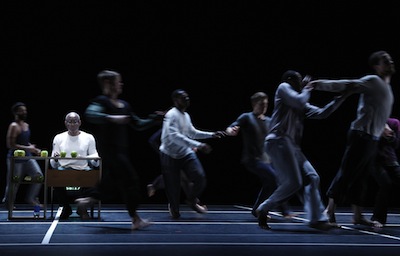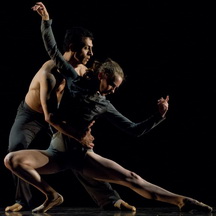
How long is a story?
Among the one-minute stories that comprise Bill T. Jones’ new work Story/Time is one in which a fellow artist points out some item that she finds aesthetically appealing. Jones retorts that he’s “not into nostalgia.” The woman smiles and replies, “You will be.”
The comment is remarkably predictive for of all the words that can characterize the stories of Story/Time, nostalgia is the most pithy.
Story/Time was performed by Jones and his remarkable company this past February 24 and 25 at Cal Performances. It is intellectual in its structure: its connection to John Cage’s Indeterminancy is direct and has been described in detail: in this piece Cage tells 70 one-minute stories during one seamless performance, the selection and order of the stories dependent on chance. Jones likewise allows a computer to select which 70 stories out of over 150 he will tell and in which order. Similarly, the dancers have some 35 movement “events” that are subject to chance. The music, brilliantly played by electronic composer Ted Coffey, is also changing and changeable, mixing musical genres deftly.
The nightly shifts to the work’s overall structure force a vibrant alertness on everyone. As if that wasn’t intrinsic to Jones’ choreographic style on the body, which is demanding, athletic and electric. These dancers’ minds are also on red alert.
The stage sets, by sculptor and set designer Bjorn Amelan, are pared down to two large moving screens that are semi-transparent and form kinetic walls or suggested rooms through which the dancers move. Jones, himself, sits at a table in the midst of his whirling dancers. Above him a large fluorescently green digital clock ticks out the seconds of each story.
Because some of the stories need more words in order to make their point or come to a conclusion, Jones reads them differently. Some are read quickly, the sounds spilling out in a continuous stream; others require long pauses in order to fill out the minute’s 60 seconds.
How long is a life?
The stories, however, are intimate and personal. Many of them fleeting recollections of admired artists and very New York in their self-conscious descriptions of the last generation’s avant-garde: Merce Cunningham, Louise Nevelson, Virgil Thomson. Others tell of Jones’ family, especially his mother. One story comes back in various forms, which weaves the overall piece together despite its random structure: Jones and his mother, Estella, go to visit the Nazi camp Therensienstadt, where many artists were imprisoned and died during the war. His mother doesn’t quite understand the purpose of the German memorial, and she tells him, “Son, if you want to learn to play the guitar, you have to sit there all night in the graveyard, and in the morning you will have learned.”
This rather dark motherly advice, which happened fairly early in the performance, returns, most often in renditions of the song “John Henry.” Jones sang this song and parts of it—once, just the word “hammer” repeated over and over—throughout the performance. He has a beautiful voice, a resonant and rich bass.
Some of the stories sink deeper into Jones’ emotional world. There is the lovely description of the natural world outside the home where his partner Arnie Zane was dying of AIDS-related lymphoma. This story begins with a one-word sentence “March”—placing us succinctly in the time-bound world. It evokes a strangely Japanese sense of beauty, with its attendance on the ephemeral and bittersweet awareness of how the transitory is bound into the natural world.
This quality of fragility within life and time drifts throughout the physical appearance of the performance as well. Smoke appears in short, localized moments: it follows a body rolling across the floor or hangs in the spotlights revealed above the stage. Bodies move naked through shadows. It is nostalgia, in its most delicate sense, that suffuses this piece, providing an unexpected nuance to the restless muscularity of the dancers.
—Jaime Robles
Photo: Bill T. Jones and the Bill T. Jones / Arnie Zane Dance Company. Photo by Paul B. Goode
